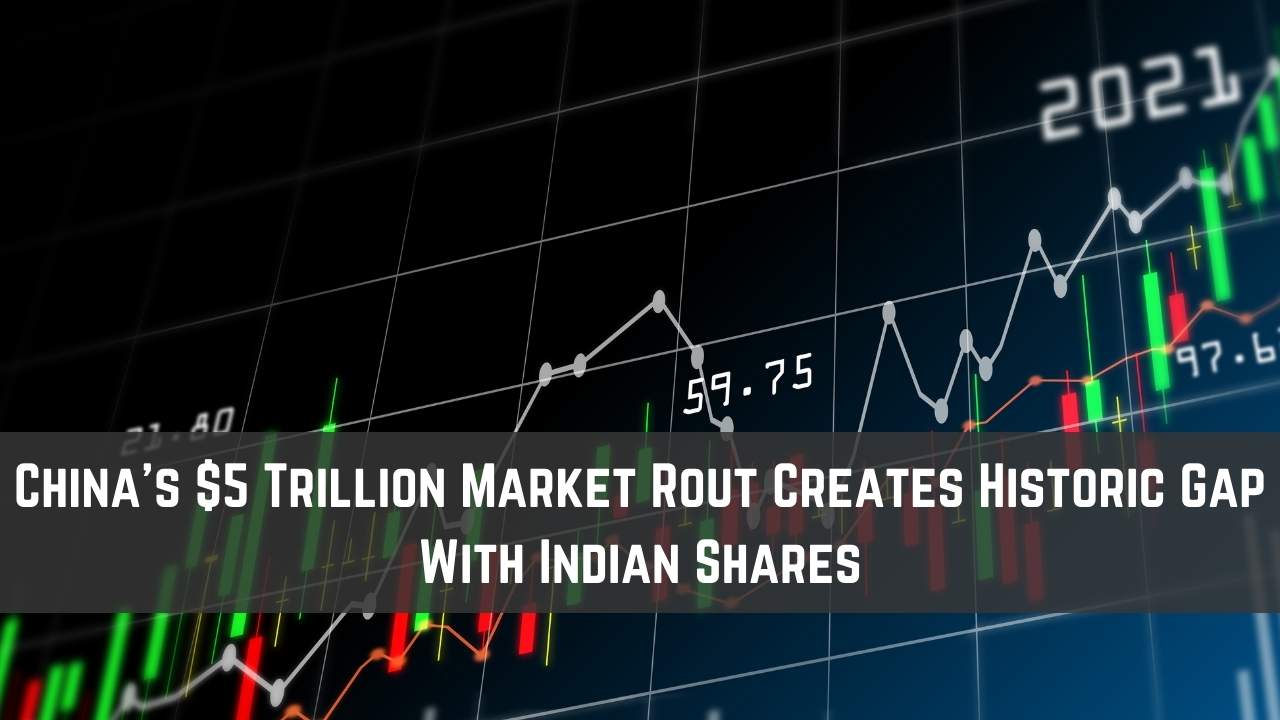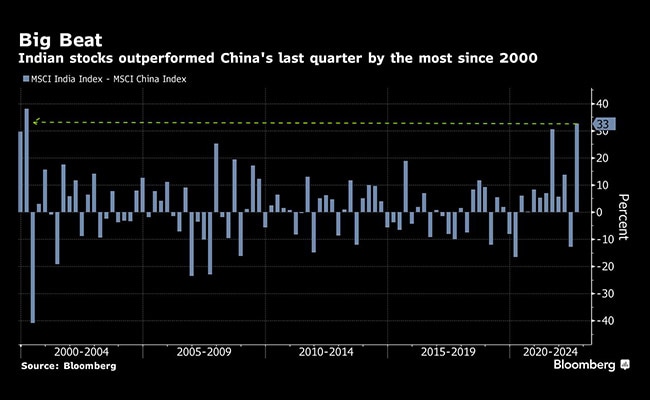China's $5 Trillion Market Rout Creates Historic Gap With Indian Shares

Last Updated: 13th December 2022 - 08:31 pm
India dubbed the "next China," has emerged as an attractive alternative with Asia's fastest economic growth.
Comparatively to the MSCI India index, which increased by nearly 10% in the recently ended quarter, the MSCI China index fell by 23%. The largest gain since March 2000 was 33% for the MSCI India index.

Due to Beijing's COVID Zero initiative, regulatory crackdowns, and tensions with the West, Chinese stocks have fallen by $5 trillion since the beginning of 2021. And India, long dubbed the "next China," has emerged as a promising alternative thanks to Asia's strongest economic growth.
Market veteran Mark Mobius has prioritized India over China since the start of this year. India is a significant holding in some of Jupiter Asset Management's emerging-market funds, the company claims. The amount of money M&G Investments (Singapore) PTE allocates to India will be increased in 2022.
Why is India outperforming China?
(1) Because of its thriving domestic market, India may fare better than most other emerging countries in the event of a global recession. In the long run, China's decoupling from the US may open doors for Indian businesses to expand their global footprint.
(2) As China's draconian lockdowns continue to have an impact on these supply chains, the demand for an alternative is growing.
(3) Significant foreign firms have benefited from South Asia's impressive manufacturing capabilities. Apple Inc., which has traditionally manufactured the majority of its iPhones in China, began manufacturing the new iPhone 14 in India earlier than expected following a flawless production rollout. Citigroup Inc. sees India as an important overseas market for expansion.
As a result of its growing market influence, India's weight in the MSCI Emerging Markets Index has increased by more than 7% points in the two years leading up to September. The overall performance of Chinese and Hong Kong stocks has dropped by more than ten points.

When did divergence start?
The significant divergence between the two stock markets began in February 2021, when tightening liquidity conditions in China contributed to the unwinding of a two-year bull market in equities. Meanwhile, thanks to an unprecedented retail investing boom, Indian equities have continued to set new highs.
Since then, the MSCI China Index's aggregate market value of enterprises has fallen by $5.1 trillion, and the index closed Friday (30 September 2022) at its lowest level since July 2016. The MSCI India Index, which reached a new high earlier this year, has gained approximately $300 billion.
Additionally, investor positioning has changed. India is receiving record amounts from global EM funds, while China is only modestly recovering from a sharp decline in recent quarters.
The growing investor capital allocation to Asia ex-China and India-only funds suggests that this shift is still in its early stages. Some of the obstacles to investing in China seem to be more long-lasting and structural than anticipated.
On an earnings-based valuation, Indian stocks are undoubtedly the most expensive in Asia as a result of months of outperformance. This has caused some investors to exercise caution, and the Reserve Bank of India's interest rate increases are another element that could have an impact on the market's outlook.
On the other hand, once the economy is freed from Covid restrictions, China could experience a significant upswing. By one metric, the trading price of its Hong Kong-listed stocks is the lowest it has ever been.
However, investors with a longer-term growth story in mind are firmly convinced. According to economists surveyed by Bloomberg, the economy will expand by about 7% in the fiscal year that ends in March, which is more than twice as fast as China's expected to do in 2022. India's population will grow faster than China in the upcoming years due to its size, youth, and supportive environment for private enterprise.
Major international corporations have profited from the South Asian nation's superior industrial capabilities. Following a smooth production rollout, Apple Inc., which has historically produced the majority of its iPhones in China, started producing the new iPhone 14 in India earlier than expected. India is one of the key international markets that Citigroup Inc. is focusing on for growth.
India's weight in the MSCI Emerging Markets Index has increased by almost 7 percentage points in the two years leading up to September due to its growing market clout. The combined performance of Chinese and Hong Kong stocks has decreased by more than 10 points.
Regardless of how the Chinese market does, India's appeal to international investors is still a long-term trend. With one of the most skilled management teams in all of Asia, India's stock market is home to some of the highest calibre businesses in the region. India excels in a number of industries, including consumer goods and services, healthcare, and financial services.
Key takeaway:-
- China's $5 trillion rout creates a historic gap with Indian stocks.
- The MSCI China index slumped by 23% in the just-ended quarter compared to the MSCI India index, which rallied by almost 10%.
- The MSCI India index outperformed by 33%, which is the biggest since March 2000. A $5 trillion decline in Chinese stocks has occurred since early 2021 as a result of Beijing's COVID Zero drive, regulatory crackdowns, and tensions with the West.
- Apple Inc., which has historically produced the majority of its iPhones in China, started manufacturing the new iPhone 14 in India earlier than anticipated after a flawless production rollout.
- Chinese and Hong Kong stocks' aggregate performance has decreased by more than ten points.
Trending on 5paisa
Discover more of what matters to you.
Disclaimer: Investment in securities market are subject to market risks, read all the related documents carefully before investing. For detailed disclaimer please Click here.
 Sachin Gupta
Sachin Gupta 5paisa Research Team
5paisa Research Team